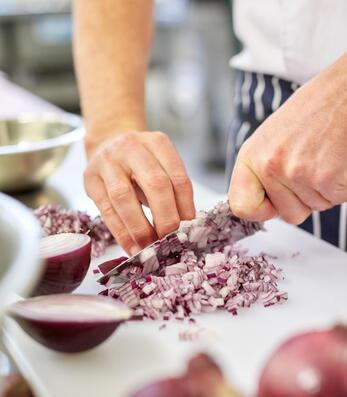

Views: 500 Author: sales@insightknife.com.cn Publish Time: 2025-03-01 Origin: Site








Content Menu
>> Introduction to Chef Knife Grips
>> Handle Grip: Beginner’s Comfort
>>> How to Hold the Knife Using the Handle Grip
>>> Advantages:
>>> Disadvantages:
>> Pinch Grip: Professional Control
>>> How to Achieve the Pinch Grip
>>> Advantages:
>>> Disadvantages:
>> Guide Hand Positioning: Protecting Your Fingers
>>> How to Position the Guide Hand
>>> Advantages:
>> Cutting Techniques: Mastering the Knife
>>> Key Techniques to Focus On:
>> Safety Tips: Reducing the Risk of Injury
>> Common Mistakes and How to Fix Them
>> Tips for Beginners: Getting Started with Chef Knife Handling
>> Advanced Tips for Professional Chefs
>> Conclusion: Perfecting Your Chef Knife Skills
A chef's knife is one of the most versatile tools in the kitchen. Whether you're chopping vegetables, slicing meat, or mincing herbs, holding your knife correctly can significantly improve your precision, safety, and overall cooking efficiency. A proper grip also reduces the risk of injury and fatigue, making it an essential skill for both beginner and seasoned chefs. In this guide, we will explore the different methods for holding a chef knife, delve into the benefits of each grip, and provide tips to enhance your cutting technique.
There are several ways to hold a chef knife, each with its unique benefits. The most common grips include:
Handle Grip
Blade Grip (Pinch Grip)
Variations of the Pinch Grip
Each grip has its distinct characteristics and applications. Let’s dive deeper into these methods and explore when and why you should use them.

The handle grip is often the first grip that beginners learn. This grip is exactly what it sounds like: holding the knife by the handle with your fingers wrapped around it. It provides a comfortable, secure hold, but offers limited control compared to other grips.
Wrap your fingers around the handle, ensuring that the heel of your palm is against the end of the handle. Your thumb should rest on the opposite side of the handle.
Keep your fingers relaxed. There’s no need to grip too tightly, which can lead to hand fatigue.
This grip is ideal for basic tasks like chopping and slicing. However, it doesn’t provide much leverage for precision cutting.
Comfortable for beginners.
Provides a firm hold.
Low risk of injury due to the natural position of the hand.
Limited control for fine, precise cuts.
Can cause hand fatigue during long cutting sessions.
The pinch grip, or blade grip, is preferred by more experienced chefs due to its superior control and balance. This method involves using your thumb and index finger to pinch the blade itself, with your remaining fingers wrapped around the handle.

Position the Thumb and Index Finger: Place your thumb on one side of the blade, just in front of the bolster (the thick part of the blade near the handle), and your index finger on the opposite side of the blade.
Grip the Handle with Your Other Fingers: Use your middle, ring, and pinky fingers to wrap around the handle. These fingers should provide additional support, but they do not control the knife.
Adjust the Grip Pressure: The grip should be firm enough to allow for precision, but not so tight that it causes unnecessary tension in your hand.
Superior control and balance, making it ideal for precise cuts.
Allows for better maneuverability, especially when cutting delicate ingredients like herbs.
Reduces fatigue during extended cutting sessions, as the weight of the knife is better distributed.
Can feel uncomfortable for beginners due to the direct contact with the blade.
Requires more practice to master the technique.
When cutting, it’s essential to use your guide hand (the hand that is not holding the knife) to stabilize the food and protect your fingers from the blade. The correct positioning of your guide hand is crucial for both safety and precision.
Curl Your Fingers Inward: To protect your fingers, curl them inward, keeping your knuckles exposed. The knife should rest against your knuckles as a guide.
Keep Your Guide Hand Steady: Your guide hand helps to guide the knife in a straight line and ensures even, uniform cuts. It should not move erratically while cutting.
Protects your fingers from accidental cuts.
Helps you achieve even, uniform slices.
Mastering the right cutting technique is just as important as holding the knife correctly. Proper technique allows you to make smooth, controlled cuts without straining your hand or wrist.
Circular Motion: One of the most effective cutting motions is a circular or rocking motion. This allows the knife’s blade to maintain contact with the cutting board, resulting in cleaner cuts and less fatigue.
Consistency and Rhythm: Maintaining a consistent rhythm in your cuts is essential for efficiency. Avoid rushing through tasks and aim for steady, controlled movements.
Keep the Knife Parallel to the Cutting Board: Ensure the knife stays parallel to the cutting board to make consistent slices.

Using a chef knife requires focus and caution. Below are some important safety tips to ensure you can cut efficiently and avoid injury:
Use a Stable Cutting Surface: Ensure your cutting board is non-slip and stable to prevent the knife from slipping.
Avoid Cutting Toward Yourself: Always cut away from your body to prevent accidents.
Stay Focused: Distractions can lead to accidents. Always stay focused on your task.
Use the Right Knife for the Job: If you’re cutting through bones or hard vegetables, a chef knife may not be the best tool. Use a specialized knife for such tasks to prevent injury.
Even seasoned chefs can fall into bad habits. Here are some common mistakes to watch out for:
Incorrect Grip: One of the most common mistakes is placing fingers on the blade instead of gripping it correctly. This can lead to instability, lack of control, and hand fatigue. Ensure your grip is on the handle or blade itself, and avoid touching the sharp edges.
Improper Guide Hand Position: If your guide hand is not curled properly, your fingers are exposed to the blade. Make sure your knuckles are in line with the knife to protect your fingers.
Overgripping: Gripping the knife too tightly can cause unnecessary tension in your hand and arm, leading to fatigue. Focus on a relaxed, controlled grip that allows for smooth, continuous cuts.
For beginners, learning how to hold a chef knife and use it properly may take time and practice. Here are a few tips to get you started:
Start Slowly: Begin by practicing with basic cuts, such as chopping vegetables or slicing fruits. Take it slow and focus on getting the grip and motion correct before moving on to more advanced techniques.
Practice Different Grips: Try both the handle grip and pinch grip to see which one feels more comfortable and gives you the most control.
Watch Tutorials: Watching instructional videos can be incredibly helpful for understanding knife grips and cutting techniques.
Gradually Build Up Your Speed: Don’t rush the process. As you gain confidence, gradually increase your cutting speed while maintaining control and precision.
Once you’ve mastered the basics, it’s time to fine-tune your technique and consider some advanced tips:
Knife Maintenance: A dull knife is more dangerous than a sharp one. Regularly hone your knife and occasionally sharpen it to keep it in optimal condition.
Use the Right Knife for the Task: A chef knife is incredibly versatile, but don’t hesitate to use specialized knives like paring knives or boning knives for specific tasks.
Ergonomics: To avoid strain and fatigue, make sure your cutting board is at a comfortable height, and take breaks to rest your hands and wrists during extended cooking sessions.
Mastering the art of holding a chef knife and using it effectively is essential for becoming a skilled and efficient cook. Whether you're a beginner or a seasoned pro, understanding the different grips, techniques, and safety tips is crucial for both safety and performance in the kitchen. With practice, your knife skills will improve, allowing you to handle a variety of cutting tasks with ease and precision.
By experimenting with different grips and techniques, you can tailor your approach to suit your cooking style and preferences, ultimately enhancing your kitchen experience.
What is the most common grip for holding a chef knife?The most common grips are the handle grip and the pinch grip. The pinch grip is preferred by professionals for its precision and control.
How do I prevent fatigue while cutting?Use a grip that feels comfortable and maintain a smooth, consistent cutting motion. Avoid placing your fingers on the blade.
What is the purpose of the guide hand in cutting?The guide hand helps stabilize the food and guides the knife, ensuring straight cuts and protecting your fingers.
Can I use the handle grip for all types of cutting?While the handle grip is comfortable, it offers limited control for precision tasks. The blade grip is better suited for fine cutting.
How do I improve my cutting skills?Practice regularly, watch tutorials, and experiment with different grips to find what works best for you.